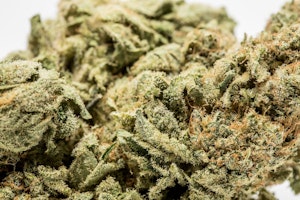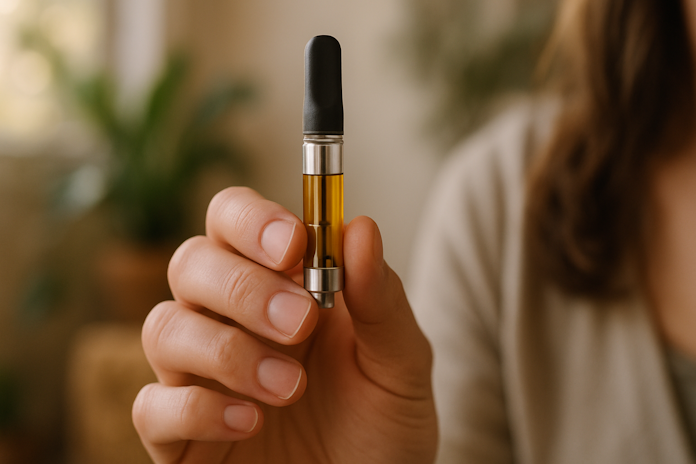
Herb
THC Carts Explained: What to Look For, Avoid, and Expect
Know what you should expect and avoid when buying THC carts.
THC carts are a widely used cannabis product valued for their portability and ease of use. Whether you’re new to vaping or need a refresher, here’s what you should know about how they work, how to use them, and how to tell the difference between high-quality and fake THC carts.
What Is a THC Cart and What Does It Look Like?
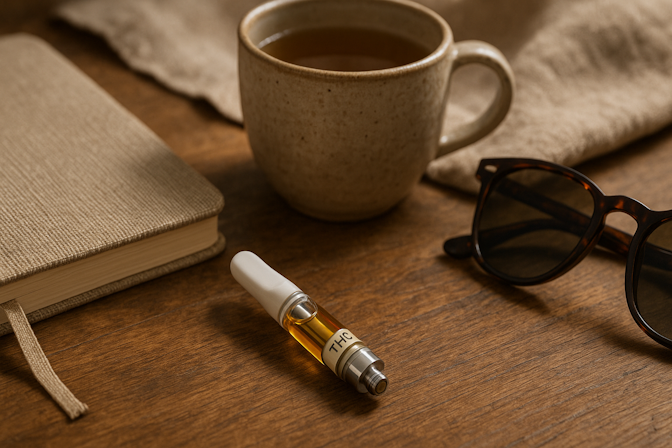
Herb
A THC cart is a small, pre-filled container of concentrated cannabis oil extracted from the cannabis plant. It’s designed to pair with a separate vape battery, which heats the oil and turns it into vapor you can inhale.
Most cartridges are made with a glass or plastic chamber, a visible metal coil or ceramic heating element, and a threaded base that screws into the battery. The oil inside can vary in texture and tone depending on the extraction method, but a clean cart typically holds translucent, golden oil. Unusual color or texture may point to improper storage or a subpar extract. Herb’s guide on what color vape cartridges should be offers a helpful breakdown of what to expect from a properly filled cart.
How to Use a THC Cart
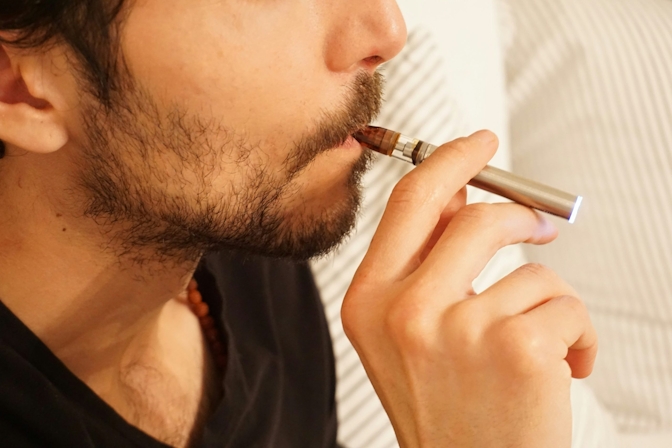
elsa olofsson / unsplash
If you’re wondering how to use a THC cart, here’s a quick guide to get started:
- Choose your vape battery: Make sure it’s compatible with 510-thread vape cartridges, unless you’re using an all-in-one or disposable vape.
- Attach the cart: Screw the cart onto your battery until it’s snug, but don’t overtighten it.
- Power it up: Turn on your battery (usually by clicking 5 times quickly).
- Adjust voltage (if applicable): Lower settings are better for flavor; higher settings create a more potent hit.
- Inhale: Press the button while drawing slowly from the mouthpiece. Start with small puffs to gauge potency.
- Exhale and wait: Effects typically kick in within minutes.
To get the most out of your cart, look for a battery with adjustable temperature control, long battery life, and automatic shut-off features.
What to Expect When Vaping a THC Cart

Eli Defaria / unsplash
Vaping THC oil from a cart offers fast-acting effects and a smooth experience compared to smoking cannabis flower. You can expect:
- Quick onset (5 to 10 minutes)
- Euphoric effects from the primary psychoactive compound, THC
- High potency, depending on the oil
- A discreet and flavorful experience, especially with strain-specific oils like Pineapple Express
Compared to edibles, weed carts kick in faster and are easier to dose. Unlike smoking, you won’t get the smell of burnt plant material; instead, you’ll get the scent of vapor. But they’re not risk-free. Some users report intense psychoactive effects with highly potent carts, especially if they hit too much too quickly.
Side effects can include dry mouth, dizziness, anxiety, or coughing. If it doesn’t have an authentic taste, stop using the cart.
What to Look For in a Quality THC Cartridge
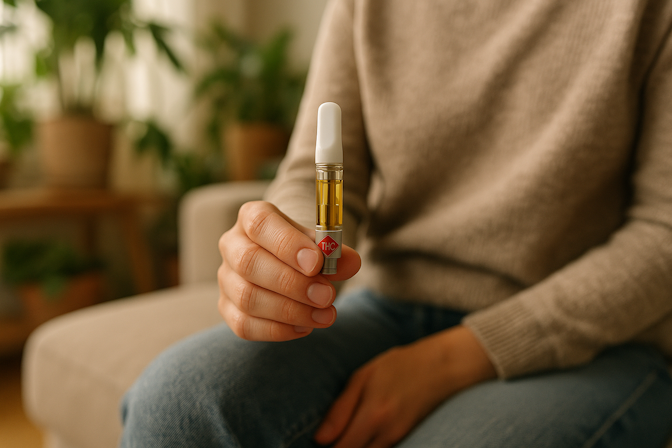
Herb
Not all THC cartridges are made with the same standards, and spotting the difference between a well-made product and something questionable can make a major impact on your experience. A quality THC cartridge should be clearly labeled, properly sealed, and filled with oil that’s consistent in color and clarity. A light golden to amber oil is usually a good sign, indicating proper extraction and storage. Oil that’s too dark or too thick can point to age, contamination, or poor processing.
The packaging should include full product details, such as cannabinoid content, strain name, extract type (e.g., distillate, CO2, live resin, or rosin), and a batch number that links to third-party lab results. You should also be able to scan a QR code or visit the brand’s website to review the Certificate of Analysis (COA). This verifies potency and checks for contaminants like pesticides, residual solvents, and heavy metals.
High-quality carts also use good hardware. Look for ceramic or stainless steel components, not cheap plastic or off-brand atomizers. Poorly made hardware can affect vapor quality and may leach unwanted materials into the oil when heated. A reliable THC cartridge should produce clean, even vapor, maintain consistent airflow, and match the effect and flavor profile of the strain listed on the label.
Red Flags and Fake THC Carts to Avoid
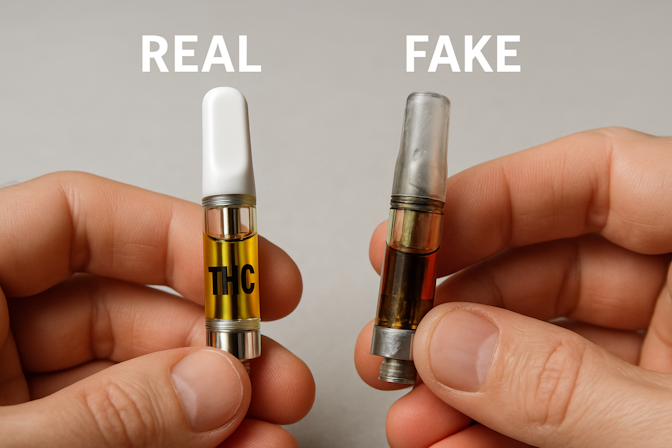
Herb
Fake or low-grade THC carts still make their way into the market, often through unlicensed sellers or online resellers. Some use packaging that mimics authentic brands, making it harder to spot issues at first glance. What sets them apart is usually found in the details, like how the oil looks, how the hardware functions, and whether the product provides any testing information at all.
When a THC cartridge hasn’t been tested or manufactured properly, the risks go beyond weak effects. Some may contain leftover solvents, harsh additives, or unknown ingredients that cause headaches, nausea, or lung irritation. Others use cheap hardware that can overheat or break down, especially with repeated use. Products like these are difficult to evaluate just by looking at the box.
The most reliable way to protect yourself is by checking for specific quality indicators, starting with how the oil appears, how the cart performs, and whether the product includes verified lab results.
Red Flag #1: Oil Color Dark or Murky
The color of the oil can tell you a lot about the condition and quality of a THC cart. While natural variations happen depending on the extract, high-quality oil typically falls somewhere between light gold and amber. If the oil looks very dark, thick, or cloudy, it could be old, poorly refined, or contaminated. According to Herb’s guide on vape cartridge color, significant darkening may suggest oxidation or that the oil was exposed to heat, light, or air for too long.
While not always a sign of a fake, darker oil often raises questions about freshness or processing.
Red Flag #2: Lack of Clear Labeling
Legit THC vape cartridges always come with clear branding, potency information, strain name, and cannabinoid/terpene content. If the cart doesn’t tell you what’s in it or who made it, don’t trust it. Clear labeling is often your first clue that the product was legally manufactured and tested. A lack of information is a major red flag, especially in unregulated markets.
Red Flag #3: No COA or Testing Info
All regulated cannabis vapes should come with a verifiable certificate of analysis (COA) from a third-party lab. If the cart doesn’t have a QR code or batch number that you can look up, skip it. Without test results, there’s no way to verify purity or potency. You can read more about how to read a COA here: Herb COA Guide.
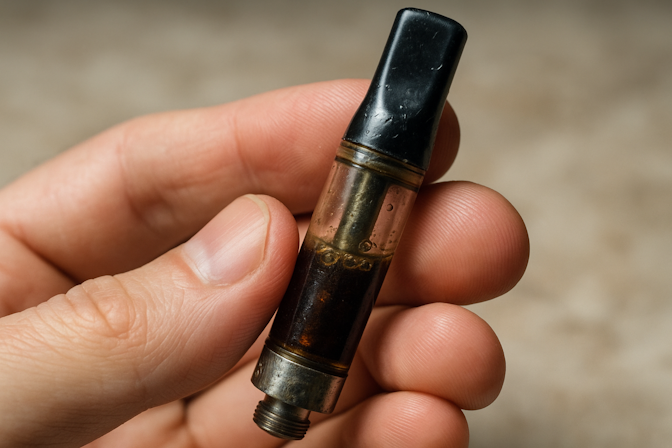
herb
Red Flag #4: Suspicious Additives or Ingredients
Always check the ingredient list when possible. If a cart contains synthetic flavorings, thinning agents, or anything other than cannabis oil and natural cannabis-derived terpenes, that’s a problem. Ingredients like vitamin E acetate or propylene glycol have been linked to serious lung injuries. Even botanically-derived terpenes can pose a threat, as they may be derived from unknown sources that could contain potential contaminants. A high-quality THC vape cart should be simple and clean.
Red Flag #5: Extremely Thick or Thin Oil
If the oil looks like syrup or is barely moving, it may have waxes or fats that don’t belong. On the other hand, if it’s thin and watery, it may be diluted with questionable solvents. THC distillate and live resin cartridges should have a consistent, honey-like viscosity. Too thick or too thin means something’s off.
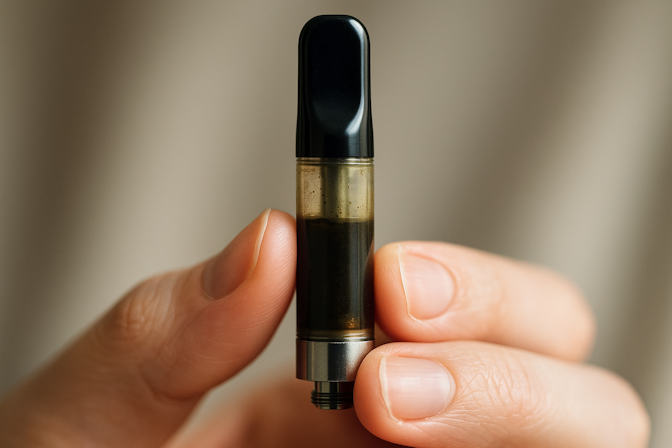
Herb
Red Flag #6: Burnt or Strange Taste
A burnt, chemical, or metallic taste usually means the oil is contaminated or the heating element is faulty. It may also indicate the presence of leftover solvents or degraded terpenes. A proper cart should offer a smooth, flavorful experience, not one that is harsh, strange, or painful to inhale. If it tastes off, stop using it.
Red Flag #7: Health Symptoms After Using
If you feel lightheaded, dizzy, nauseous, or develop coughing fits after hitting a cart, that’s a sign something’s wrong. These could be fake THC cart symptoms, especially if they appear right after vaping. Legitimate products may cause mild side effects, but alarming physical reactions are a reason to stop immediately and check what you’re using. When in doubt, throw it out.
Are THC Carts Safe or Bad For You?

Herb
So, are THC carts safe? When legally produced and properly tested, THC vape carts can offer a relatively safe and efficient way to consume cannabis oil, especially for consumers who want fast-acting effects without the smoke or smell of flower. But the safety of THC carts depends entirely on how they’re made, what’s in them, and how they’re used.
Licensed cannabis vapes from dispensaries must pass strict state-mandated testing for potency, pesticides, residual solvents, heavy metals, mold, and mycotoxins. This helps ensure you’re inhaling pure cannabis oil, usually high-quality live resin or live rosin, without harmful additives. When you’re buying from a regulated source, it’s also easier to verify what’s in the cart via the COA (certificate of analysis), which lists the cannabinoid profile, THC concentration, and any test results for contaminants.
Where things get risky is with unregulated or fake THC carts. These may contain diluted or flavored oil blends that haven’t been tested for inhalation safety. The most infamous example is vitamin E acetate, which was linked to thousands of lung injuries (EVALI) and several deaths in 2019. That additive has since been banned in legal markets, but it’s still a risk in black market products.
Even for regulated carts, vaping THC isn’t entirely risk-free. Inhalation of heated cannabis oil may irritate the lungs or throat, especially with frequent or long-term use. Some research also suggests that vaping at high temperatures may produce trace compounds like formaldehyde, although the levels and risks are still being studied.
There’s also the issue of dependence. Because THC vape pens deliver concentrated doses with fast-acting effects, it’s easy to build a tolerance quickly. Some users find themselves reaching for carts throughout the day, leading to frequent use and reduced sensitivity to other cannabinoids.
Key safety takeaways:
- Yes, THC carts can be safe if they’re legally produced, tested, and used responsibly.
- No, THC carts are not safe if you don’t know where they came from, what’s in them, or if you’re experiencing unexplained symptoms after use.
- Use moderation, verify the source, and avoid black market or counterfeit vape cartridges.
If you’re unsure about a cart, always check the brand’s website for lab results or ask your budtender for help. And if you’re ever experiencing chest pain, shortness of breath, or nausea after vaping, stop immediately and seek medical attention.
Do THC Carts Go Bad? Storage and Shelf Life Explained
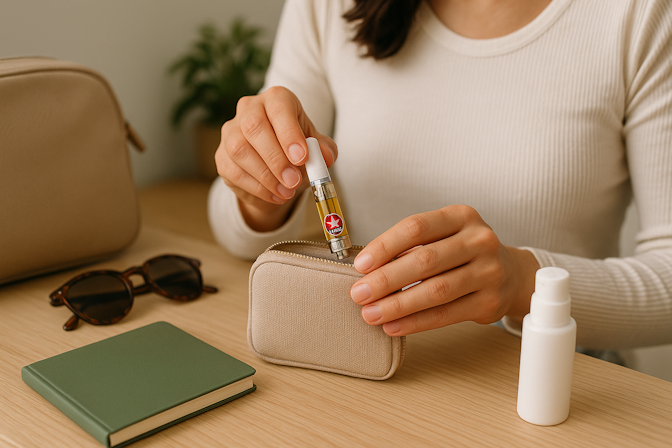
Herb
Yes, THC carts do go bad, especially when stored improperly or left unused for extended periods. While many vape cartridges can remain stable for up to a year, their shelf life depends on the type of oil, the quality of the hardware, and the storage conditions. Exposure to heat, light, or air speeds up oxidation and terpene degradation, which can alter the flavor, potency, and overall experience.
To extend the shelf life, store THC carts upright in a cool, dry place. Avoid keeping them in direct sunlight, near heat sources, or your car; any environment with temperature swings can cause leaks or oil breakdown. Sealed, unused carts that are kept in optimal conditions tend to last 12 to 18 months without major issues. Once opened, it’s best to finish the cart within a few months for peak quality.
Signs of an Expired THC Cart
- Oil has turned unusually dark or thick
- Cloudiness or clumping inside the cartridge
- Crystals forming near the bottom or along the walls
- Vapor production is weak, inconsistent, or uneven
- Flavor tastes burnt, stale, or chemically sharp
- Oil is leaking from the mouthpiece or base
Using an expired THC cart can result in a noticeably harsher inhale or reduced effects. As the oil breaks down, the original cannabinoid content may no longer be active, and the cannabis terpene profile that once gave it flavor and aroma may have degraded or disappeared. Some expired carts also develop a bitter aftertaste or produce vapor that feels dry or irritating on the throat. If the oil smells off, the texture has changed, or the cart performs differently than it used to, it’s best not to finish it. Even if the risks are minimal, expired oil rarely delivers a satisfying or reliable session.
Final Thoughts
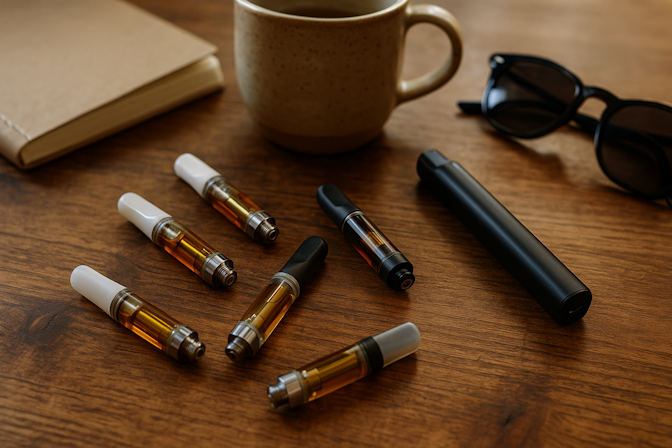
Herb
THC carts can be a reliable option for cannabis consumers who prefer vapor over smoke, but only if the product is clean, tested, and stored properly. Poor-quality cartridges are still common, and visual inspection isn’t always enough. Knowing what to look for can help you avoid most of the guesswork. When in doubt, skip carts that raise concerns and opt for products with full transparency from trusted brands.
Herb Recommended Products:
READ MORE

